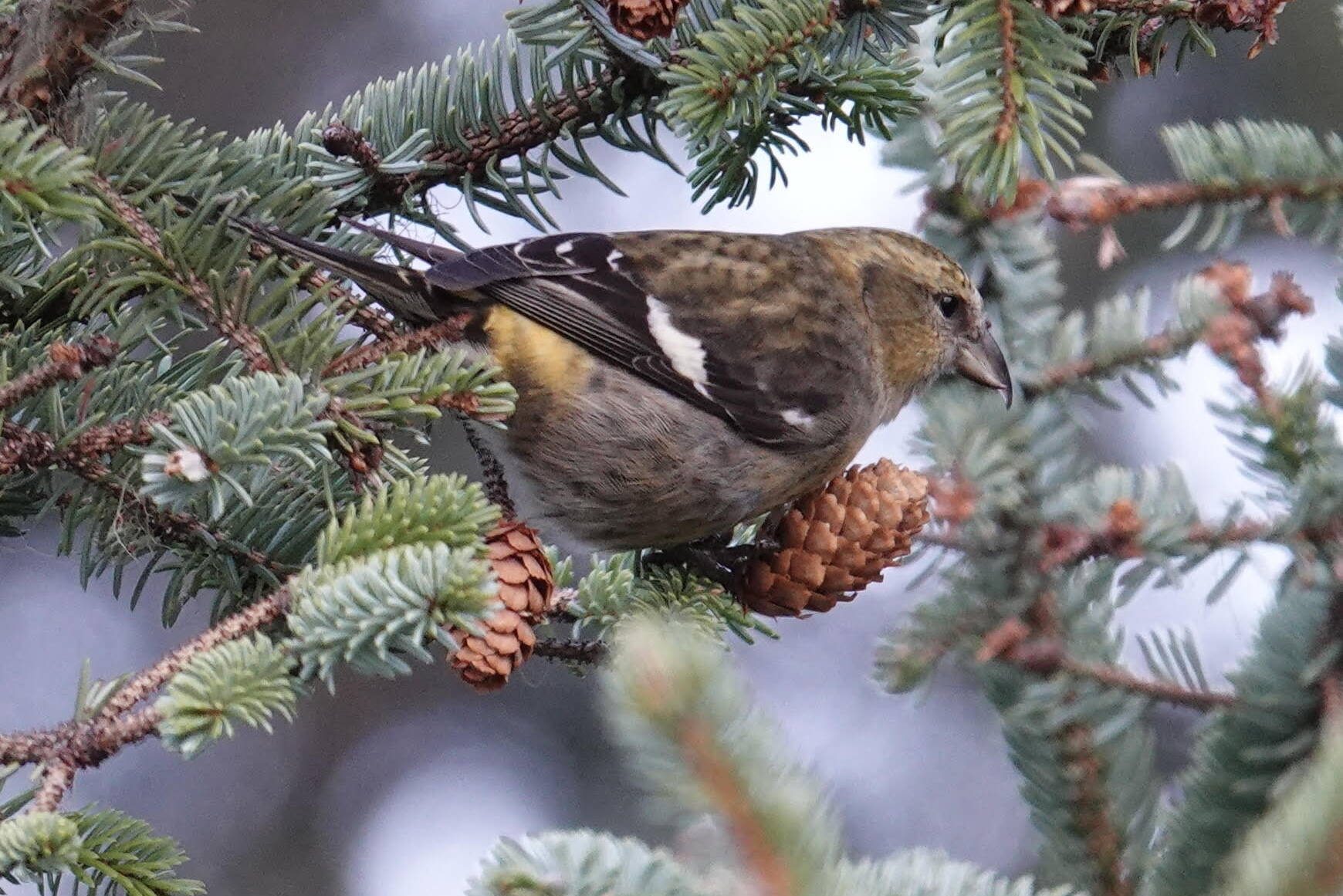Most birds have bills with tips that come together when the jaws close. But not crossbills — hence their common name. The crossed bill tips are so unusual that they once were sometimes mistakenly thought to be the result of injury or developmental errors. But no, those crossed bill tips are actually an adaptation to the birds’ feeding methods. The lower bill may be crossed to the left or to the right, with respect to the upper bill.
Crossbills can feed from cones that are still attached to the tree, but they also may pull off a cone and hold it in a leg for convenient feeding. These birds are specialized for feeding on conifer seeds, using the crossed bill to open cone scales so the seeds can be extracted. They can open closed cones but also use those whose scales have opened (if the seed is still there). A foraging crossbill bites between two scales of a closed cone and slides its closed bill between the two cone scales. The decurved upper bill presses against the lower scale on the cone while the lower bill is opened a little (moving in the direction that the tip is pointed), pushing on the upper scale. That action, often with a twist of the head as well, spreads the cone scales apart. A seed is extracted from its attachment point, moved into a special groove in the mouth, where the seed coat can be removed and discarded.
The seeds of most conifers are usually wind-dispersed. But when a bird (or a squirrel) grabs a cone and eats some of the seeds, some may be left in the cone. As the most distal scales are smaller and have fewer seeds, they are often left behind. So if the cone is still on the tree, the unharvested scales may open spontaneously and disperse the remaining seeds by wind. Each cone scale typically bears two seeds, and I wonder if the harvesting birds ever drop some seeds, perhaps contributing to dispersal.
Crossbills are classified as finches, along with pine siskins, redpolls, goldfinches, and others. Most crossbills breed in the northern and montane forests of North America and Europe. There are two main sorts, known as red crossbills (Loxia curvirostra) and white-winged crossbills (L. leucoptera), each of which tends to favor certain conifers. But each sort may contain more than one species: different populations commonly have differences in bill size and shape, favored conifers, and vocalizations that could, upon further study, be deemed sufficient to distinguish separate species within each sort. In addition, down in the high mountains of the Caribbean island of Hispaniola, there is one endangered crossbill, left behind when the Ice Age glaciers retreated; it feeds on pine seeds there.
White-wings usually feed on spruce or larch (tamarack) seeds. Red crossbills of different populations tend to specialize on particular conifer species: on ponderosa pine, or hemlock, or Douglas fir, or lodgepole pine, for example. Body size and bill depth are related to the size and hardness of the favored cones…smaller bills for hemlocks, larger bills for pines, etc. And the size of the seed-extraction groove differs accordingly too. Although crossbills favor certain conifer seeds, they will eat less favored conifer seeds and other things too, as needed: insects, leaf buds, small snails, grass seeds, and so on.
The white-winged crossbill has been seen here in Juneau in several places this winter. They nest farther north than the red crossbill, but sometimes leave their far-north nesting area for parts farther south. Even within the breeding range, they tend to be somewhat nomadic, moving about to breed where cone crops are good. When they appear south of their breeding range, that is also thought to be in response to failures of northerly cone crops or perhaps to a build-up of population numbers too big for the cone crops to support.
Redpolls and siskins also move about to find good places to feed on seeds. They too move south in big numbers, which is often called a population irruption. They’ll stay (for a while) wherever they find food for the winter and then go back north for breeding. Seed-eaters are not the only boreal species that sometimes irrupt—for example, owls of several species from the far north sometimes come south in large numbers, if their prey (rodents, mostly) populations have crashed.
With luck, crossbills might show up during the Audubon Society Great Backyard Bird Count, which happens on Feb. 16-19 (the website is www.birdcount.org). Look for them out there.
• Mary F. Willson is a retired professor of ecology. “On The Trails” appears every Wednesday in the Juneau Empire.

